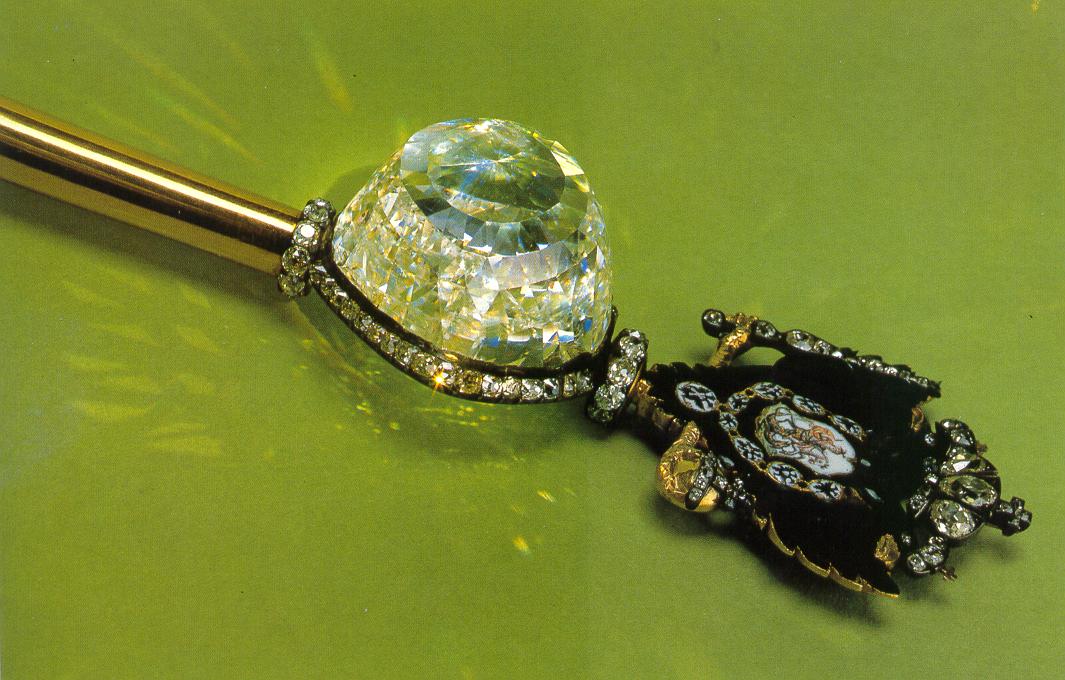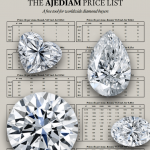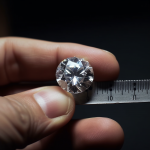Diamond Prices
Read moreThe Orlov Diamond
Mystery, Theft, Love, and Power
The Orlov Diamond is one of the most famous diamonds in the world. Its natural beauty is rivaled only by the magic of its intricate origin story. Was it the long-lost Great Mugal Diamond? Did it receive the Orlov name from a man who was hopelessly in love with Empress Catherine II The Great? Did the brilliant diamond help him succeed in his quest for love?
If you’d like to learn more about the Orlov, in this article you will find:

- Discovered in
- Uncertain, potentially in the 17th century
- Country of Origin
- Uncertain, potentially India
- Mine of Origin
- Not specified
- Carat Weight
- Rough: Unknown
- Cut: 189.62 carats
- Cut Shape
- Indian-style rose-cut
- Clarity
- Typical of an Indian diamond of fine quality, with a faint blue-green tint
- Color
- Faint blue-green tint
- Previous Owners
- Shafrass (Iranian millionaire)
- Count Grigory Orlov
- Current Owner
- Kremlin, part of the Russian Crown Jewels
- Estimated Value
- Purchased for a purported 1.4 million Dutch florins (equivalent to approximately eighty-four million dollars today)
The Origins of the Orlov Diamond
It is impossible to tell the story of the Orlov diamond without mentioning the Great Mogul Diamond. Scholars have often linked the two because of their similarities, and there is a popular theory that they were actually the same diamond!
The Orlov Diamond and the Great Mogul Diamond mix up
Several, intertwining mysteries surround the elusive Orlov and Mogul diamonds. That is to say, it is unclear which origin story belongs to either stone. One example of the blurry line that divides both stories can be appreciated on the subject of how both diamonds made their way to Europe. Another corresponding aspect between the two is that both stones were unearthed in India around the 17th century. Moreover, both stones were cut in an incredibly similar way, reminiscent of an old rose-cut or an egg cut in half.
The likeness between the folklore surrounding these two stones is uncanny. Seeing the resemblance between the legends, it is easy to understand why some might say that they are indeed one and the same.
The Orlov Diamond Origin Legends – the Deceitful Frenchman and Nadir Shah’s soldier
The legend says that a French deserter trying to escape the 18th-century Carnatic Wars in the Hyderabad region, stole the diamond from an Indian temple, by disguising himself as a Hindu, and taking refuge there. The Frenchman immediately noticed a large diamond that was the eye of the temple deity and knew exactly what he was going to do. It took him many years to gain the trust of the community and be left near the statue alone.
After waiting so long for the right time, the deserter jumped at the first opportunity. He dislodged the diamond with his knife, and then swiftly made his escape. Neither the French con man nor the Orlov diamond was ever seen again.
A very similar piece of legend holds that the Orlov Diamond was amongst the loot the Persians under Nadir Shah had acquired from the Moguls by looting Delhi in 1739. The Persians hauled away many riches, among which might have been the Orlov, the Koh-i-Noor, and countless other riches. However, a violent death soon found the immensely rich Nadir Shah. Many have questioned what happened to his many riches.
One particular legend says that one of the bodyguards of the Shah was seen in a nearby town after his death with many of his master’s possessions, including the Orlov diamond. Afterward, he was never seen again.
The legends about the French and Afghan soldiers bear striking similarities which have led many historians to conclude that the precious gemstone was in fact the same in both stories. Alas, it is impossible to truly know what happened.
The Orlov Diamond Finds its Way to Amsterdam
One way or another, the stone found its way to Amsterdam, the diamond capital of the world at the time. By that point, it was in the possession of an Iranian millionaire by the name of Shaffrass. The Orlov Diamond had drawn the attention of much international royalty. Yet, the asking price for the gem was extortionate. A buyer was yet to be found who could acquire the magnificent stone.
The cutting of the Orlov Diamond
Catherine II the Great envisioned the Orlov Diamond mounted atop her Imperial Scepter as a symbol of her imperial wealth and power. Surrounded by many others, the Orlov would become the crown diamond of the scepter. The best diamond cutters in the Kremlin fulfilled Catherine’s desire and produced a stone that was an Indian-style rose-cut of 189.62 carats (37.924 g).
Catherine II The Great’s Imperial scepter
The scepter is made out of a burnished shaft that is split into three sections and possesses eight sets of hoops adorned with brilliant-cut diamonds. Some of these gems are around 30 carats each and 15 of these gemstones are 14 carats each. The Orlov is set at the top, with its most elevated part facing upwards; undoubtedly the scepter’s main attraction. Rising above the Orlov is a double-headed eagle with an enameled crest on its breast, the shield of Arms of Russia. It is key to mention that the Orlov was not specifically cut for this, rather, the scepter was designed around it.
The cutting of the Orlov as evidence of confusion
The task of cutting the Mogul fell on a man named Borgio of whom little is known except for his work on the Great diamond. The jeweler was against cutting the gemstone into smaller pieces. Instead, he wanted to produce a single great stone that was worthy of the rough diamond, however, his approach required him to grind away a significantly larger portion of the stone. The diamond ended up as an Indian-style rose cut, just like the Orlov.
Borgio’s work yielded very poor results. Not only did the diamond lose a lot of weight it also retained lots of its inclusions, which greatly displeased the Emperor. Following the theory that the Great Mogul and the Orlov are, in fact, the same gem – the Orlov is what Borgio cut. The diamond cutters in the Kremlin would have merely repolished the gemstone. Many scientists support the theory because the Orlov has a traditional Indian rose style cut, which was very rare in the 18th century and could have only been done by a master jeweler.
The Modern Ownership History of the Orlov Diamond
With the help of Hovhannes Lazarian, Count Grigory Orlov purchased the diamond from Shafrass, an Iranian millionaire for a purported 1.4 million dutch florins which are close to eighty-four million dollars today.
Count Orlov’s Romantic gesture
The nobleman wanted the gift to represent a grand romantic gesture, as well as to remind Catherine II of his help in establishing her as the ruler of Russia. The empress is infamous for her various relations with different men during her marriage to Peter III. A lot of them, including Count Orlov himself, was instrumental in the coup d’état that dethroned Tsar Peter and cemented Catherine’s rule in Russia. The loyalist Orlov was Catherine’s lover for many years, which her husband was unaware of. Catherine even had an illegitimate son from the Count, whom she kept away from the palace, in the city of Tula.
Catherine II the Great had larger plans for her country and herself, uninterested in marrying the Count. She wanted to remain the Dowager Empress of Russia and had no more use for him in terms of politics, strategy, or advice. Although Catherine enjoyed his company, she also learned that Count Orlov had been involved with other women and ultimately decided to put an end to their romantic relationship.
How the Diamond Receives the Orlov Name
Count Orlov and his brothers continued to be showered with attention, titles and presents from Catherine II. The Count was even given a palace after she officially became an Empress. However, the nobleman still seemed madly in love with Catherine and wanted to reconcile and marry her. Count Orlov tried to impress the Empress through the glamorous gift of a diamond, fit for her imperial scepter, hoping that he would win and regain her affection. Alas, Catherine II accepted the stone, but not Count Orlov himself. However, she named the stone after the Count to honor him.
The Alternative History of the Purchase of the Orlov Diamond
Interestingly, there is an alternative story that suggests the big romantic gesture wasn’t one after all. Supposedly, a document exists between Count Orlov and Lazarev, who was the court jeweler at St Petersburg for the purchase of the Orlov Diamond. The document suggests that Catherine II the Great was interested in buying the stone herself and the Count was a mere mediator. It was known that the Empress had shown interest in the diamond beforehand, which gives this version some merit.
The Technical Characteristics of the Orlov Diamond
The Orlov Diamond has the shape of an egg cut in half, weighing 189.6 carats. Its clarity is typical of an Indian diamond of fine quality and has a faint blue-green tint to it. Based on the GIA’s system, the Orlov Diamond belongs alongside some of the clearest gemstones in the world. There is not much information available about the stone since it has not moved from the Imperial Scepter since it was set there by the Empress.
Kremlin released data that stated the diamond was 32 millimeters x 35 millimeters x 21 millimeters and confirmed its weight as 189.62 carats (37.924 g). However, this data is under question since the Orlov has not been formally weighed since its purchase by the Count.
The Significance of the Orlov Diamond
The Orlov Diamond remains one of the most famous gemstones in the world. It is a historical monument of grand proportions with a size and shape that are extremely rare and a cut that reminds us of long-lost times. The ownership of Catherine II the Great also shows the rise to power of a magnificent woman who would not let anything stop her ambition. The Russian Imperial scepter was the hallmark of the Empress’ power and cemented her place as a monarch in the world and history.
Nowadays, the Orlov Diamond is available to see in the Gokran, the Diamond Fund. It is on display in the Kremlin in Moscow as part of Catherine II the Great’s Imperial scepter, alongside the rest of the Russian Crown Jewels.
We hope you enjoyed the read!
If you’d like to read about other famous diamonds like the Orlov, Eureka, or Premier Rose diamonds, you can visit Ajediam’s Famous Diamonds glossary. Or, if you’re feeling inspired, you can browse Ajediam’s premium diamond collections shop.



